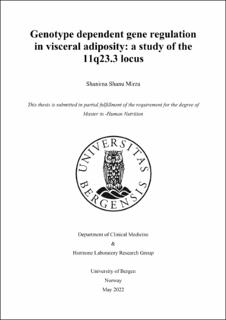Genotype dependent gene regulation in visceral adiposity: a study of the 11q23.3 locus
Master thesis
Permanent lenke
https://hdl.handle.net/11250/2998971Utgivelsesdato
2022-05-30Metadata
Vis full innførselSamlinger
- Master theses [20]
Sammendrag
Abstract Background: Overweight and obesity are defined by an excessive accumulation of adipose tissue. Adipose tissue, also known as fat, consist of specialized lipid storing cells called adipocytes. In human, adipose tissue is distributed throughout the body in two major depots: subcutaneous adipose tissue (SAT), and visceral adipose tissue (VAT). While SAT is beneficial for metabolism, VAT is associated with several metabolic disorders and increased risk of premature death. Despite the known pathological effects of VAT, the underlying mechanisms that promote selective fat storage in VAT are poorly understood and largely unexplored. However, genetics are thought to play a major role, and a recent GWAS study has identified 11q23.3 as one of several novel genetic loci associated with VAT mass. Because GWAS associations do not provide functional information, the molecular mechanisms underlying this new association are still unknown. Aim: The overall aim of this study was to investigate enhancer activities in the VAT associated 11q23.3 locus and identify the causal variant(s). Methods: Standard molecular biological methods were used to assess transcriptional activity of the cloned tiles, such as PCR, gel-electrophoresis, In-fusion cloning, and luciferase assays in appropriate adipose cell lines and a control cell line. Site-directed mutagenesis was performed to identify causal SNPs regulating the cis-regulatory (enhancer) activity. Finally, bioinformatic web tools were utilized to search for transcription factor binding sites overlapping the causal to discover upstream regulatory mechanisms. Results: We were able to clone three tiles, from both risk and protective allele types. Our data suggested that tile 8 is involved in genotype-dependent enhancer activity, and that this activity is determined by at least five causal SNPs. We identified multiple transcription binding sites overlapping the SNPs within tile 8 and found a repressive RARB site to be lost in the risk allele of rs1799993. Conclusion: Our findings suggest that tile 8 is involved in genotype dependent enhancer activity of the 11q23.3 locus, and at least five likely causal SNPs, were identified. Among these, the rs1799993 risk variant may disrupt retinol-RARB anti-adipogenic signaling, leading to increased VAT mass. Abstract Background: Overweight and obesity are defined by an excessive accumulation of adipose tissue. Adipose tissue, also known as fat, consist of specialized lipid storing cells called adipocytes. In human, adipose tissue is distributed throughout the body in two major depots: subcutaneous adipose tissue (SAT), and visceral adipose tissue (VAT). While SAT is beneficial for metabolism, VAT is associated with several metabolic disorders and increased risk of premature death. Despite the known pathological effects of VAT, the underlying mechanisms that promote selective fat storage in VAT are poorly understood and largely unexplored. However, genetics are thought to play a major role, and a recent GWAS study has identified 11q23.3 as one of several novel genetic loci associated with VAT mass. Because GWAS associations do not provide functional information, the molecular mechanisms underlying this new association are still unknown. Aim: The overall aim of this study was to investigate enhancer activities in the VAT associated 11q23.3 locus and identify the causal variant(s). Methods: Standard molecular biological methods were used to assess transcriptional activity of the cloned tiles, such as PCR, gel-electrophoresis, In-fusion cloning, and luciferase assays in appropriate adipose cell lines and a control cell line. Site-directed mutagenesis was performed to identify causal SNPs regulating the cis-regulatory (enhancer) activity. Finally, bioinformatic web tools were utilized to search for transcription factor binding sites overlapping the causal to discover upstream regulatory mechanisms. Results: We were able to clone three tiles, from both risk and protective allele types. Our data suggested that tile 8 is involved in genotype-dependent enhancer activity, and that this activity is determined by at least five causal SNPs. We identified multiple transcription binding sites overlapping the SNPs within tile 8 and found a repressive RARB site to be lost in the risk allele of rs1799993. Conclusion: Our findings suggest that tile 8 is involved in genotype dependent enhancer activity of the 11q23.3 locus, and at least five likely causal SNPs, were identified. Among these, the rs1799993 risk variant may disrupt retinol-RARB anti-adipogenic signaling, leading to increased VAT mass.
